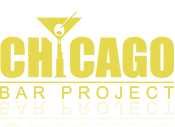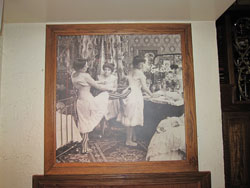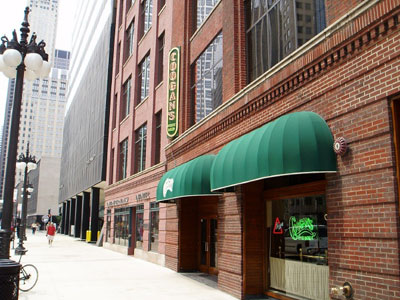 Coogan’s Riverside Saloon is the elder statesmen of bars in Chicago’s Loop. You may not think that being around for 25 years would earn a bar this notoriety but, not only is Coogan’s one of the oldest pubs, but also its 19th Century décor and location at a historical site adds to its allure. Factor in its decent selection of beers on tap and pub grub and you’ve got a widely sought after-work and pre-opera destination.
Coogan’s Riverside Saloon is the elder statesmen of bars in Chicago’s Loop. You may not think that being around for 25 years would earn a bar this notoriety but, not only is Coogan’s one of the oldest pubs, but also its 19th Century décor and location at a historical site adds to its allure. Factor in its decent selection of beers on tap and pub grub and you’ve got a widely sought after-work and pre-opera destination.
You can find Coogan’s on the west side of Upper Wacker Driver between Randolph & Lake Streets. A green marquee with red neon lettering matches the green neon sign in the window and awning over the front door. Upon entering, you’ll find a roomy, hexagonally tiled vestibule that leads to another plate-glass door opening into the pub proper. Mind the steps as you walk in as you’ll find yourself on a slightly raised wooden platform that looks out upon the single-room space.
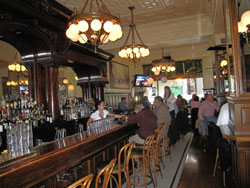 An antique mahogany bar from Africa that dates back to 1898 runs most of the length of the northern wall and is framed by antique light stands. An impressive Brunswick-like back bar with stately wooden columns is also featured, both of which were installed by Ray Wray Design, also responsible for the impressive renovations at Goose Island Brew Pub, Four Farthings and Charlie’s Ale House. A brass rail matches the tap fixtures that dispense seven, primarily imported beers priced at $6 each and in pitchers for $20 (14 more in bottles), which makes us long for the specials at Cardozo’s Pub. Grab a high-backed wooden barstool here if you’re lucky enough to find one.
An antique mahogany bar from Africa that dates back to 1898 runs most of the length of the northern wall and is framed by antique light stands. An impressive Brunswick-like back bar with stately wooden columns is also featured, both of which were installed by Ray Wray Design, also responsible for the impressive renovations at Goose Island Brew Pub, Four Farthings and Charlie’s Ale House. A brass rail matches the tap fixtures that dispense seven, primarily imported beers priced at $6 each and in pitchers for $20 (14 more in bottles), which makes us long for the specials at Cardozo’s Pub. Grab a high-backed wooden barstool here if you’re lucky enough to find one.
Waitresses dressed in white shirts, ties and black pants or skirts canvass the thick wooden cocktail tables opposite the bar and in front of large windows overlooking Wacker. Ancient brass chandeliers hang from a cream-colored tin ceiling that matches the stuccoed walls. More white hexagonal tile, large framed sepia photographs of Chicago at the turn of the last century, thick wood-paneled and mirrored columns, and hanging plants round out the décor. A carvery station lies opposite the bar along the southern wall, above which is featured an impressive display of ceramic beers steins ala Steve’s Lounge in Hegewisch. Beyond the bar is an elevated seating section with low-slung wooden tables and windows overlooking the Chicago River, though the wooden blinds are frequently drawn so as not to blind patrons after Loop business hours. A pair of restrooms lie beyond the carvery station, set into the far southern wall down a short hallway.
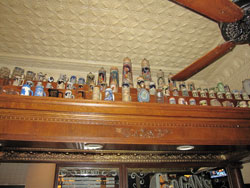 When you have that urge to spoil your dinner, popular appetizers include buffalo wings, bite-size crab cakes, fried calamari, quesadillas, and pizza bread. The main menu includes an array of sandwiches under $7, including corned beef, Italian beef and the signature Louisiana Crab Cake, all of which are available on more bread options as there are sangers: rye, pumpernickel, kaiser roll, onion roll, whole wheat, sourdough, and croissant.
When you have that urge to spoil your dinner, popular appetizers include buffalo wings, bite-size crab cakes, fried calamari, quesadillas, and pizza bread. The main menu includes an array of sandwiches under $7, including corned beef, Italian beef and the signature Louisiana Crab Cake, all of which are available on more bread options as there are sangers: rye, pumpernickel, kaiser roll, onion roll, whole wheat, sourdough, and croissant.
Two flatscreens at either end of the bar provide the only entertainment outside of boisterous after-work patrons who like to have a few (read: many) before heading to their homesteads and children, located farther-a-field. The clientele consists almost entirely of an after-work crowd except for whoever else can get away with drinking at lunchtime, and those heading in for a cocktail or two before or after a performance at the Civic Opera House.
Coogan’s is located in the six-story Great Lakes Building, originally built in 1912 as a mill and the first with green space along the river. Prior to its construction, this was the site of a temporary wigwam erected for the 1860 Republican National Convention, when Abraham Lincoln accepted the Republican nomination for President.
Prior to the Civil War era, In 1831 when the area was “Wolf Point,” this was also the site of the Sauganash Tavern opened by Mark Beaubien. The Sauganash was Chicago’s third tavern, behind Wolf Tavern and Miller House, and was named after Archibald “Billy” Caldwell, nicknamed “Sauganash” for “Englishman” in the Pottawatomie tongue. Beaubien kept his tavern “like hell” but it did host Chicago’s first election in 1833 and the city’s first theater, and was ultimately destroyed by fire in 1851. The property was converted for office use in 1981 and Coogan’s opened shortly thereafter.
“The room is well lit and seems bigger than it actually is, much like a Bennigan’s without the garage-sale junk on the wall.”
– Karl Klockars, Centerstage Chicago
So there you have it: Coogan’s is an old-fashioned, riverside saloon (hence the name), with an interior design that compliments the historic building housing it and land that it sits upon. There’s also a soft spot in my heart for Coogan’s as it is one of the first bars in the Loop I ever visited, pre-dated only by the dear-departed Govnor’s Pub (demolished in 2006). If you like Coogan’s Riverside Saloon, you may also like other classic Loop taverns, such as Monk’s Pub on Lake, Miller’s Pub on Wabash, and Exchequer Pub also on Wabash. Farther north, Glascott’s Groggery, Kincade’s and Burwood Tap offer a similar 19th Century feel in Lincoln Park. For more information, you’ll have to phone first as Coogan’s doesn’t have a website. Until next time, here’s mud in your eye.
